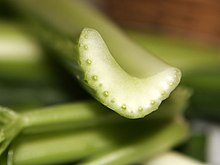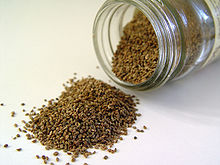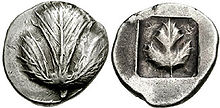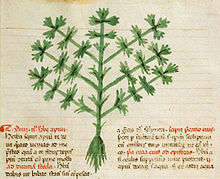Celery
| Celery | |
|---|---|

| |
| Scientific classification | |
| Kingdom: | Plantae |
| Clade: | Tracheophytes |
| Clade: | Angiosperms |
| Clade: | Eudicots |
| Clade: | Asterids |
| Order: | Apiales |
| Family: | Apiaceae |
| Genus: | Apium |
| Species: | A. graveolens
|
| Binomial name | |
| Apium graveolens L.
| |
| Synonyms[2] | |
| |
Celery (Apium graveolens) is a
Description
Celery leaves are
Wild celery, Apium graveolens var. graveolens, grows to 1 m (3 ft 3 in) tall. Celery is a biennial plant that occurs around the globe. It produces flowers and seeds only during its second year. The first cultivation is thought to have happened in the
North of the Alps, wild celery is found only in the foothill zone on soils with some salt content. It prefers moist or wet, nutrient rich, muddy soils. It cannot be found in Austria and is increasingly rare in Germany.[6]
| Cultivar | Image | Name | Part eaten |
|---|---|---|---|
| Celery |  |
Apium graveolens var. dulce | Primarily grown for its thick stalk.[7] |
| Celeriac |  |
Apium graveolens var. rapaceum | The hypocotyl is eaten like a root vegetable.[8] |
| Leaf celery |  |
Apium graveolens var. secalinum | Primarily eaten for its large leaves.[9] |
Etymology
First attested and printed in English as "sellery" by
Taxonomy

Celery was described by Carl Linnaeus in Volume One of his Species Plantarum in 1753.[15]
Cultivation
The plants are raised from seed, sown either in a hot bed or in the open garden according to the season of the year, and, after one or two thinnings and transplantings, they are, on attaining a height of 15–20 cm (6–8 in), planted out in deep trenches for convenience of blanching, which is effected by earthing up to exclude light from the stems. Development of self-blanching varieties of celery, which do not need to be earthed up, dominate both the commercial and amateur market.[16]
Celery was first grown as a winter and early spring vegetable.[17] It was considered a cleansing tonic to counter the deficiencies of a winter diet based on salted meats without fresh vegetables.[17] By the 19th century, the season for celery in England had been extended, to last from the beginning of September to late in April.[18]
North America
In North America, commercial production of celery is dominated by the cultivar called 'Pascal' celery.[3] Gardeners can grow a range of cultivars, many of which differ from the wild species, mainly in having stouter leaf stems. They are ranged under two classes, white and red. The stalks grow in tight, straight, parallel bunches, and are typically marketed fresh that way. They are sold without roots and only a small amount of green leaf remaining.[19]
The stalks can be eaten raw, or as an ingredient in salads, or as a flavoring in soups, stews, and pot roasts.[20]
Europe
In Europe, the variety called celeriac (also known as celery root), Apium graveolens var. rapaceum, is also popular. It is grown because its hypocotyl forms a large bulb, white on the inside, which can be kept for months in winter and mostly serves as a key ingredient in soup. It can also be shredded and used in salads. The leaves are used as seasoning; the small, fibrous stalks find only marginal use.[21]
Asia

Leaf celery (Chinese celery, Apium graveolens var. secalinum) is a cultivar from East Asia that grows in marshlands. Leaf celery has characteristically thin skin stalks and a stronger taste and smell compared to other cultivars. It is used as a flavoring in soups and sometimes pickled as a side dish.[22]
Wild
The wild form of celery is known as "smallage". It has a furrowed stalk with wedge-shaped leaves, the whole plant having a coarse, earthy taste, and a distinctive smell. The stalks are not usually eaten (except in soups or stews in French cuisine), but the leaves may be used in salads, and its seeds are those sold as a spice.[23] With cultivation and blanching, the stalks lose their acidic qualities and assume the mild, sweetish, aromatic taste particular to celery as a salad plant.[24]
Because wild celery is rarely eaten, yet susceptible to the same diseases as more well-used cultivars, it is often removed from fields to help prevent transmission of viruses like celery mosaic virus.[25]
Harvesting and storage

Harvesting occurs when the average size of celery in a field is marketable; due to extremely uniform crop growth, fields are harvested only once. The petioles and leaves are removed and harvested; celery is packed by size and quality (determined by color, shape, straightness and thickness of petiole, stalk and midrib[clarification needed] length and absence of disease, cracks, splits, insect damage and rot). During commercial harvesting, celery is packaged into cartons which contain between 36 and 48 stalks and weigh up to 27 kg (60 lb).[26] Under optimal conditions, celery can be stored for up to seven weeks from 0–2 °C (32–36 °F). Inner stalks may continue growing if kept at temperatures above 0 °C (32 °F). Shelf life can be extended by packaging celery in anti-fogging, micro-perforated shrink wrap.[27] Freshly cut petioles of celery are prone to decay, which can be prevented or reduced through the use of sharp blades during processing, gentle handling, and proper sanitation.[28]
Celery stalk may be preserved through pickling by first removing the leaves, then boiling the stalks in water before finally adding vinegar, salt, and vegetable oil.[29]
Sulfites
In the past, restaurants used to store celery in a container of water with powdered vegetable preservative, but it was found that the sulfites in the preservative caused allergic reactions in some people.[30] In 1986, the U.S. Food and Drug Administration banned the use of sulfites on fruits and vegetables intended to be eaten raw.[31]
Uses
Culinary

Celery is eaten around the world as a vegetable. In North America and Europe the crisp
Leaves
Celery leaves are frequently used in cooking to add a mild spicy flavor to foods, similar to, but milder than black pepper. Celery leaves are suitable dried and sprinkled on baked, fried or roasted fish or meats, or as part of a blend of fresh seasonings suitable for use in soups and stews. They may also be eaten raw, mixed into a salad or as a garnish.[33]
Seeds
In temperate countries, celery is also grown for its seeds. Actually very small fruit, these "seeds" yield a valuable essential oil that is used in the perfume industry. The oil contains the chemical compound apiole. Celery seeds can be used as flavoring or spice, either as whole seeds or ground.[34]
Celery salt
Celery seeds can be ground and mixed with salt to produce celery salt. Celery salt can be made from an extract of the roots or by using dried leaves. Celery salt is used as a seasoning, in cocktails (commonly to enhance the flavor of Bloody Mary cocktails), on the Chicago-style hot dog, and in Old Bay Seasoning. Similarly, combinations of celery powder and salt are used to flavor and preserve cured pork[35] and other processed meats as an alternative to industrial curing salt.[36] The naturally occurring nitrites in celery work synergistically with the added salt to cure food.[37]

Celery juice
In 2019, a trend of drinking celery juice was reported in the United States, based on "detoxification" claims posted on a blog. The claims have no scientific basis, but the trend caused a sizable spike in celery prices.[38][39]
Nutrition
| Nutritional value per 100 g (3.5 oz) | |
|---|---|
| Energy | 67 kJ (16 kcal) |
2.97 g (including fiber) | |
| Starch | 0.00 g |
| Sugars | 1.34 g |
| Dietary fiber | 1.6 g |
0.17 g | |
| Saturated | 0.042 g |
| Trans | 0.000 g |
| Monounsaturated | 0.032 g |
| Polyunsaturated | 0.079 g |
0.69 g | |
Niacin (B3) | 2% 0.320 mg |
| Pantothenic acid (B5) | 5% 0.246 mg |
| Vitamin B6 | 4% 0.074 mg |
| Folate (B9) | 9% 36 μg |
| Vitamin B12 | 0% 0.00 μg |
| Choline | 1% 6.1 mg |
| Vitamin C | 3% 3.1 mg |
| Vitamin D | 0% 0 IU |
| Vitamin E | 2% 0.27 mg |
| Vitamin K | 24% 29.3 μg |
Copper | 4% 0.035 mg |
| Iron | 1% 0.20 mg |
| Magnesium | 3% 11 mg |
| Phosphorus | 2% 24 mg |
| Potassium | 9% 260 mg |
| Sodium | 3% 80 mg |
| Zinc | 1% 0.13 mg |
| Other constituents | Quantity |
| Water | 95.43 g |
| †Percentages estimated using US recommendations for adults,[40] except for potassium, which is estimated based on expert recommendation from the National Academies.[41] | |
Raw celery is 95% water, 3%
Allergies
Celery is among a small group of foods that may provoke allergic reactions; for people with celery allergy, exposure can cause potentially fatal
The Apium graveolens plant has an
Chemistry
The main chemicals responsible for the aroma and taste of celery are butylphthalide and sedanolide.[46]
History

Daniel Zohary and Maria Hopf
M. Fragiska mentions an archeological find of celery dating to the 9th century BC, at Kastanas; however, the literary evidence for ancient Greece is far more abundant. In Homer's Iliad, the horses of the Myrmidons graze on wild celery that grows in the marshes of Troy, and in Odyssey, there is mention of the meadows of violet and wild celery surrounding Calypso's Cave.[49]
In the Capitulary of
The name "celery" retraces the plant's route of successive adoption in European cooking, as the English "celery" (1664) is derived from the French céleri coming from the Lombard term, seleri, from the Latin selinon, borrowed from Greek.[52]
Celery's late arrival in the English kitchen is an end-product of the long tradition of seed selection needed to reduce the sap's bitterness and increase its sugars. By 1699,
Celery makes a minor appearance in colonial American gardens; its culinary limitations are reflected in the observation by the author of A Treatise on Gardening, by a Citizen of Virginia that it is "one of the species of
After the mid-19th century, continued selections for refined crisp texture and taste brought celery to American tables, where it was served in celery vases to be salted and eaten raw. Celery was so popular in the United States during the 19th century and early 20th century that the New York Public Library's historical menu archive shows that it was the third most popular dish in New York City menus during that time, behind only coffee and tea. In those days, celery cost more than caviar, as it was difficult to cultivate. There were also many varieties of celery back then that are no longer around because they are difficult to grow and do not ship well.[56]
Cultural depictions

A
The fifth incarnation of the Doctor in the British science fiction show Doctor Who wore a decorative stick of celery on his lapel. In the show, the Doctor would state that the celery would turn purple when exposed to certain gases in the praxis range, in which case he would eat the celery. Ironically, Peter Davison did not like celery.
See also
- Apium virus Y
- Celery mosaic virus
- Celery powder
- Celery vase
- Liriomyza trifolii – celery leaf miner
- Vallisneria americana – wild celery
- List of vegetables
References
- .
- ^ "Apium graveolens". Germplasm Resources Information Network. Agricultural Research Service, United States Department of Agriculture. Retrieved March 31, 2016.
- ^ a b de Vilmorin, Roger L. (1950). "Pascal celery and its origin". Journal of the New York Botanical Garden. 51 (602): 39–41.
- OCLC 512819711.
- OCLC 875386204.
- OCLC 886822563.
- ^ "Celery". www.bbcgoodfood.com. Retrieved 2022-04-23.
- ^ "Celeriac". www.bbcgoodfood.com. 2022-04-23. Retrieved 2022-04-23.
- ^ Baessler, Liz (2020-12-17). "Celery Leaf Info: Learn About Growing Celery As Herb Plants". www.gardeningknowhow.com. Retrieved 2022-04-23.
- ISBN 0-71-390442-9
- ^ Lewis, Charlton T.; Short, Charles (eds.). "selinon". A Latin Dictionary. Perseus Digital Library, Tufts University.
- ^ Liddell, Henry George; Scott, Robert (eds.). "σέλινον". A Greek-English Lexicon. Perseus Digital Library, Tufts University.
- ^ "celery". Etymonline.com.
- ^ "celery". Palaeolexicon.com. Archived from the original on 2016-04-13. Retrieved 2016-04-01.
- ^ Linnaeus, C (1753). Species Plantarum: Tomus I (in Latin). Holmiae. (Laurentii Salvii).
- ^ "How to grow celery / RHS Gardening". www.rhs.org.uk. Retrieved 2022-01-04.
- ^ a b Ody, Penelope (March 15, 1993). The Complete Medicinal Herbal. Dorling Kindersley. p. 37.
- ^ William Robinson and W. P. Thomson (1920). The Vegetable Garden (3rd ed.). New York, E.P. Dutton and company. p. 227.
- ^ "Celery: A History of Celery - Food Reference Articles". www.foodreference.com. Retrieved 2022-02-17.
- ^ "Top 10 ways to use up leftover celery". BBC Good Food. Retrieved 2022-06-26.
- ^ Schuchert, Wolfgang. "Celeriac (Apium graveolens L. var. rapaceum)". Crop Exhibition. Max Planck Institute for Plant Breeding Research. Archived from the original on 20 May 2012. Retrieved 28 January 2012.
- ^ Newman, Jacqueline (Fall 2006). "Chinese Celery". Vegetables and Vegetarian Foods. 13 (3): 15–34. Archived from the original on 17 April 2017. Retrieved 17 April 2017.
- ^ "Smallage". Practically Edible: The World's Biggest Food Encyclopedia. Archived from the original on 2008-10-10. Retrieved 2009-05-03.
- ^ Judd, Angela (2017-11-12). "Five Tips For Growing Celery". Growing In The Garden. Retrieved 2023-09-05.
- ^ Wellman, F (February 1937). "Control of Southern Celery Mosaic in Florida by Removing Weeds That Serve as Sources of Mosaic Infection". United States Department of Agriculture. 54 (8): 1–16. Archived from the original on 25 April 2017. Retrieved 21 April 2017.
- ^ Takele, Etaferahu. "Celery Production: Sample Costs and Profitability Analysis" (PDF). UC Davis. University of California Agriculture and Natural Resources. Archived (PDF) from the original on 2017-04-17. Retrieved 16 April 2017.
- .
- ^ Cantwell, M; Suslow, T. (2002-06-10). "Celery: Recommendations for Maintaining Postharvest Quality". Post-harvest technology research and information center. Archived from the original on 2008-04-23. Retrieved 2008-03-04.
- ^ "The power of pickles: a guide to preserving almost everything – from jam-making to chutneys". the Guardian. 2020-04-28. Retrieved 2022-09-14.
- ISBN 978-0-06-074094-8.
- ISBN 978-0-470-12709-4.
- ^ "Celery - Ingredient". FineCooking. Archived from the original on 2017-05-22. Retrieved 2021-10-08.
- ^ "How to Use Celery Leaves". FoodPrint. 2019-10-15. Retrieved 2022-02-17.
- ^ McGee, Harold (1984). On Food and Cooking: The Science and Lore of the Kitchen. Scribner. p. 414.
- ^ "Hot Dogs, Bacon, Celery Powder and Cancer Risk - American Institute for Cancer Research %". American Institute for Cancer Research. 26 July 2017. Retrieved 15 September 2020.
- ^ "Duped In The Deli Aisle? 'No Nitrates Added' Labels Are Often Misleading". NPR.org. Retrieved 15 September 2020.
- ^ "Is celery juice a viable alternative to nitrites in cured meats?". Office for Science and Society. Retrieved 2022-09-14.
- ^ Meltzer, Marisa (June 27, 2019). "Why Is Everyone Drinking Celery Juice as if It Will Save Them From Dying?". The New York Times. Archived from the original on 2022-01-01.
- ^ Uguen-Csenge, Eva (29 March 2019). "Celery prices soar as juice shops struggle to meet demand from latest health fad". CBC News. Retrieved 9 January 2020.
- ^ United States Food and Drug Administration (2024). "Daily Value on the Nutrition and Supplement Facts Labels". Retrieved 2024-03-28.
- )
- PMID 8337856.
- ISSN 0567-7572.
- ^ "Food labelling and packaging in international trade". General labelling standards for the UK and EU.
- ^ ISBN 9781607744917.
- .
- ^ D. Zohary and M. Hopf, Domestication of Plants in the Old World, (3rd ed. 2000) p.202.
- ISBN 978-1-84569-017-5, retrieved 2022-10-04
- ^ .
- ^ "Oldcook : Capitulary of Charlemagne, De villis vel curtis imperialibus". www.oldcook.com.
- S2CID 85808284.
- OED, s.v. "Celery".
- ^ Evelyn, J. (2005) [1699]. Acetaria: A Discourse of Sallets. B. Tooke; The Women's Auxiliary of Brooklyn Botanic Garden; Project Gutenberg.
- ^ Quoted in Ann Leighton, American Gardens in the Eighteenth Century, 1976, p. 199.
- ^ "David Shields, "American Heritage Vegetables"". Archived from the original on 2015-10-01. Retrieved 2016-11-27.
- ^ "When Celery Was More Special Than Caviar". Sporkful podcast.
- Pliny, Natural HistoryXIX.46.
External links
- . Encyclopædia Britannica. Vol. 5 (11th ed.). 1911.
- Apium graveolens in Plant Resources of Tropical Africa (PROTA)
- Quality standards, from the USDA website

